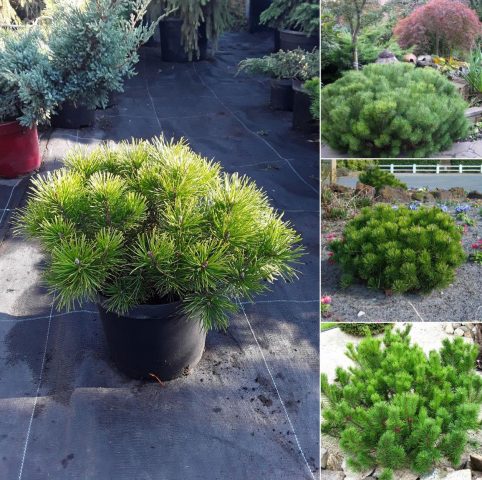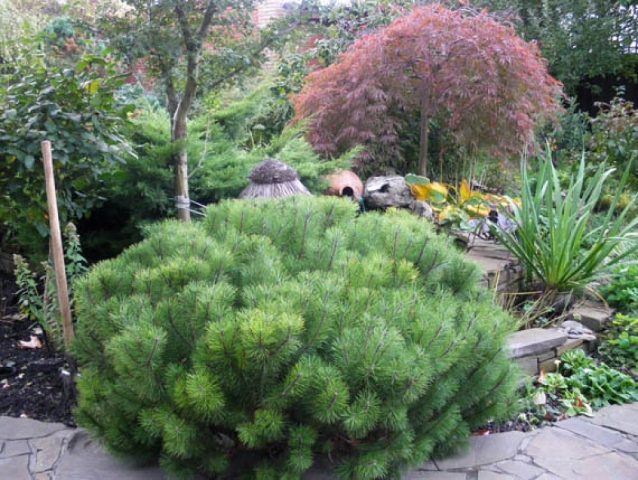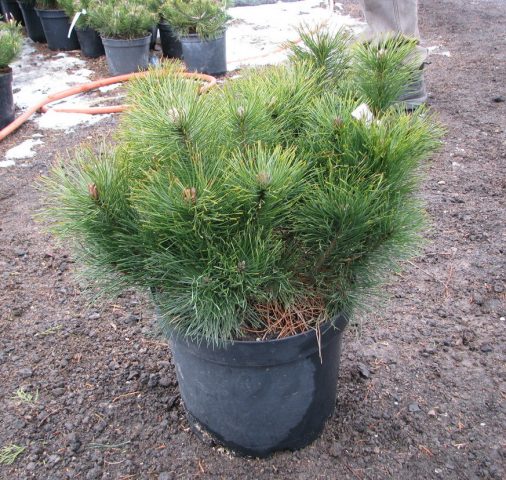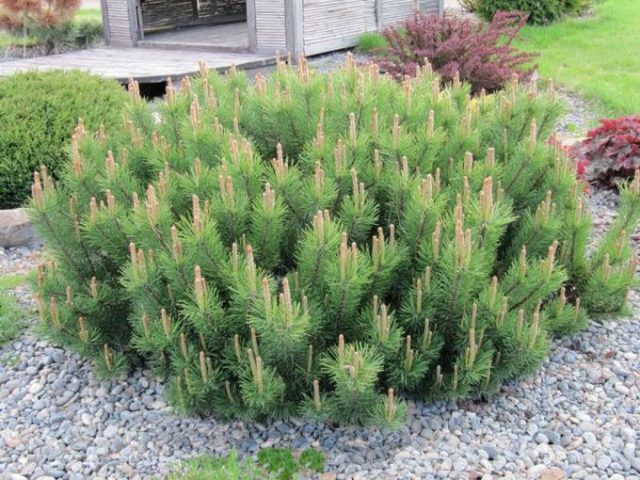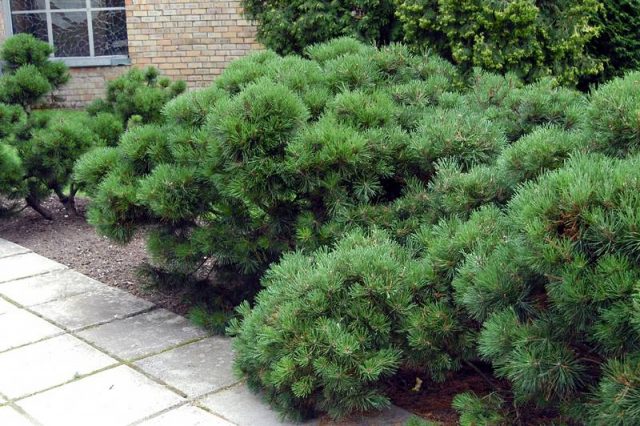Content
Regardless of fashions, bonsai are hugely popular in private gardens. Even on large plots there is a ceremonial area where the owners try to plant all the best and most beautiful. The mountain pine Pumilio is a stunted coniferous plant that invariably attracts attention. If we add that it is easy to care for a tree, and it lives for a long time, since it is not a variety, but a subspecies, then the culture becomes desirable in every area.
Description of Mugo Pumilio pine
Mountain Pine (Pinus mugo) is a species belonging to the Pine genus (Pinus), in turn, part of the Pine family (Pinaceae). It has an extensive range, there are two geographical races and several natural forms. One of the subspecies is the Mountain Pumilio Pine (Pinus mugo var. Pumilio), which is called Swiss in America.
The culture grows in the mountains of Eastern and Central Europe, most often in the Alps, Carpathians and the Balkans, climbing up to 2600 m above sea level. There she lives up to 1500-200 years.
The plant is a slow-growing shrub that forms a flat-round crown with densely spaced branches of different lengths. Shoots are directed horizontally, young ones are greenish, old ones are grayish-brown. The bark cracks with age and becomes covered with dark brown, almost black scales.
The old mountain pine Pumilio, which has passed the mark of 30 years, reaches a height of 1.5 m with a crown diameter of 3 m. After a certain age, it practically does not grow in height, gradually adding in volume.
The culture is a slow-growing one. The average size of an adult plant of the mountain pine Pumilio up to 30 years old is more than modest - the diameter of the crown is about 1.2-1.5. The height at this age is almost never more than 0.9-1 m. Is it possible to overfeed the bush with nitrogen, but this will weaken the ephedra, sharply reduce frost resistance, and can cause its death.
The needles of Pumilio are green, sharp, collected in bunches of 2 pieces, for a pine it is very short - only 3-8 cm. The needles differ greatly in length, but more often their size is closer to the lower border, the smallest are located at the ends of the shoots. The kidneys are large, well visible.
Pumilio begins to bloom and bear fruit at the age of 6 to 10 years. Anther opening occurs at a time when the leaves of other trees have not yet fully blossomed. So the exact flowering time depends on the region and the weather.
Cones are located on very short petioles, almost sessile, 2-5 cm long. The shape is ovate-rounded, the upper scutellum on the scales is noticeably protruding, the lower one is concave. Young buds are bluish to purple in color. They ripen around November of the year following pollination, with the color varying from yellowish to dark brown.
Mountain pine Pumilio in landscape design
Before planting the mountain pine Pumilio on the site, you need to consider a few points. Although it is a dwarf, slow-growing culture, over time the bush will reach 1 m, and after 30 years - 1.5 m. It is difficult to replant an adult mountain pine, and the old one may not survive the operation at all.
We are not talking about a container culture grown in a special container for the very purpose of placing ephedra of any age on the site. There, the root is minimally injured.
Of course, an adult mountain pine can also be transplanted.But this is done with a specially prepared root system, or a frozen earthen lump, that is, in winter. To do it yourself, not only is it difficult, but amateurs will still make a lot of mistakes and can destroy the pine tree. So you have to invite a highly qualified specialist, but he will take expensive work for the job.
So a flower bed, rockery or rock garden should "dance" around a mountain pine, and not vice versa. That is, as the bush grows, it will remain in place, and the site will be re-planned, and some crops will be replaced by others. Perhaps the design will change dramatically. If the owners love change, they will be happy about it. The rest should think everything out in advance.
Perhaps it is worth planting a mountain pine in the background and surrounding it with creeping roses with conifers, beautiful ground covers. When Pumilio grows up, she will not have to be moved, and crops can be swapped for larger ones.
This mountain pine tree is perfect for planting in the parterre (front area), rocky gardens, terraces, exquisite flower beds. But it is rarely and neatly placed in landscape groups. And Pumilio is absolutely not suitable for the role of tapeworm - its beauty should be emphasized by other plants. And planted alone or in a group on the lawn, it will simply be lost - the pine needles are green, and the bush will merge with the grass.
Planting and caring for the mountain pine Pumilio
If the site is selected correctly, planting and caring for the mountain pine will not give Mugo Pumilio much trouble. First of all, it should be remembered that the culture grows in the mountains, therefore, it prefers moderately fertile, well-drained soils and a sunny position. Pumilio will treat stony inclusions favorably, but will not tolerate soils that are lumpy or dense, and if the groundwater is close or permanently lodged in the root area, he will die.
Seedling and planting plot preparation
The best time for planting mountain pine is spring in regions with cold or temperate climates, autumn and all winter in the south. Container-grown Pumilio can be placed on the plot at any time. But in the south, it is better to postpone the operation in the summer until the onset of steadily cool weather.
If there is black soil or imported soil on the site, you will have to prepare the substrate for planting mountain pine yourself. To do this, mix sod land, sand, clay. If necessary, add 200-300 g of lime to the planting pit. Under the Pumilio pine, add 100-150 g of nitroammofoska or a bucket of leaf humus.
A planting hole is dug so that there is a drainage layer of gravel or stones of at least 20 cm, and a pine root. The width should be 1.5-2 times the volume of the earthen coma. The standard size of the pit for planting Pumilio can be considered a depth of about 70 cm, a diameter of 1.5 m.
When choosing seedlings, you need to be guided by the following rules:
- Pines grown in local nurseries are preferred.
- The projection of the crown of a dug mountain pine should be less than an earthen clod.
- A plant grown in a container should not have roots protruding through the drainage hole.
- Never buy a bare root seedling.
Naturally, the branches should be flexible, the needles are fresh and fragrant, without signs of disease. Overdrying the earthen coma is unacceptable, despite the fact that pine is a drought-resistant crop. While Pumilio is in the container, it should be watered regularly!
Pines are often sold with dry, yellow or brown needles. This is a sign of trouble - Pumilio was sick, overdried, or had already died altogether. If the buyer is not sure that he can independently determine the quality of a plant with red needles, it is better to refuse a seedling.
Preparing the mountain pine Pumilio for planting consists in keeping the root system in a moderately moist state.
Landing rules
The planting process of the mountain pine Pumilio differs little from other conifers. The pit is prepared at least 2 weeks in advance, drainage is laid, 70% filled with substrate and filled with water. Landing is done in the following sequence:
- Take out part of the substrate from the pit.
- Place the seedling in the center. The root collar of mountain pine should be at ground level.
- They fall asleep with an earthen lump, constantly softening the soil.
- Watering the Pumilio sapling.
- The soil under the pine is mulched with conifer bark, peat or completely rotted wood waste.
Watering and feeding
Mountain pine Pumilio is a very drought tolerant crop. It needs to be watered regularly only for the first month after planting, if it was carried out in the fall, and until the end of the season, when earthworks were carried out in the spring.
An important element of care is autumn moisture recharge. In order for the culture to winter safely, and frost cracks do not form on the bark, in dry autumn, mountain pine is abundantly watered several times - the soil must be saturated with moisture to a great depth.
Pine in nature grows on very poor soils, and mountain - generally on stones. Pumilio is not a variety, but a subspecies, that is, taken from nature without significant domestication. She does not need regular feeding, except for the first years, until she completely takes root.
If everything is in order with the mountain pine, it does not get sick and is rarely affected by pests, feeding is done until the age of 10, and then it is stopped. It should be borne in mind that seedlings under 4-5 years old are not allowed for sale by bona fide producers.
If starter fertilizer has been added to the planting hole, the owners can be calm. Mountain pine does not need to be fed for an additional 2-3 years.
Foliar dressing is quite another matter. Experienced gardeners never refuse them, but simply set aside a day every 2 weeks to spray all crops. Ephedra respond well to the chelate complex. The mountain pine Pumilio has green needles, so an additional dose of magnesium sulfate is useful for it.
Foliar dressing supplies the plant with trace elements that are poorly absorbed through the root. They increase the pine's own immunity, increase its decorative effect, and reduce the negative impact of urban ecology.
Mulching and loosening
It is necessary to loosen the soil only the first time after planting. After 1-2 years, the operation is replaced by mulching - this is more useful for mountain pine. So the roots of Pumilio are not injured, a favorable microclimate is created, and the top layer of the soil is protected from drying out.
Pruning
Formative pruning of the Pumilio Mountain Pine is not necessary. Sanitary is carried out before the buds begin to open, removing all dry and broken branches. In this case, special attention must be paid to the inner part of the crown so that there are no dead shoots left there.
Preparing for winter
If species trees of mountain pine winter well in the third zone, then Pumilio is more frost-hardy, and endures 46 ° C without shelter. But we are talking about an adult, well-rooted plant.
In the first year after planting, mountain pine is covered with spruce branches or white agrofibre, and the soil is mulched with a layer of at least 7-10 cm, in all regions. The exceptions are those where the temperature remains positive throughout the winter.
In cold regions, a shelter is also built for the second season. In zone 2, it is advisable to insulate the mountain pine Pumilio until the age of 10, taking into account the years that she spent in the nursery, that is, no more than 5 winters after planting.
Reproduction of mountain pine Pumilio
Despite the fact that the Internet is replete with articles describing pine cuttings, this method of propagation usually ends in failure, even in nurseries. For fans, a twig can take root only by accident.
Particularly rare varieties, which Pumilio does not belong to, are propagated by grafting. But this is such a complicated operation that not every nursery has a specialist of the appropriate level. It is better not for amateurs to undertake this operation.
Pumilio is a subspecies (form) of mountain pine. It can be propagated by seeds, while the maternal traits cannot be lost for the simple reason that this is not a variety. In addition, the planting material can be collected independently.
The seeds ripen in the second year after pollination, around November. After stratification, about 35% of the seeds emerge within 4-5 months. In order not to create problems for yourself, if possible, the cones are simply left on the tree until spring.
First, the seeds are sown in a light substrate, kept moist until germination. Then the seedlings dive into a separate container. They are planted in a permanent place at the age of 5.
Diseases and pests
Pumilio pine is a healthy plant that, with proper care and no overflow, rarely causes problems. Possible pests include:
- pine hermes;
- pine aphid;
- common pine scab;
- mealybug;
- pine scoop.
To kill insects, insecticides are used.
Most often, the mountain pine Pumilio is sick with resin cancer. Overflows and clogging soil cause many problems to the culture - the resulting rot is difficult to treat, especially root rot. At the first sign of the disease, the mountain pine Pumilio should be treated with a fungicide.
To avoid problems, it is imperative to do preventive treatments, and regularly inspect the bush.
Conclusion
The mountain pine Pumilio is a beautiful, healthy crop. Its small size and slow growth make it attractive for use in landscaping. This pine is undemanding and resilient and can be planted in low-maintenance orchards.
